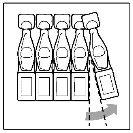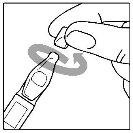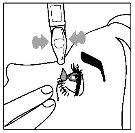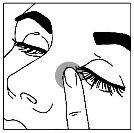
BIMATOPROST STADA 0.3 mg/ml EYE DROPS SOLUTION IN SINGLE-DOSE CONTAINERS

How to use BIMATOPROST STADA 0.3 mg/ml EYE DROPS SOLUTION IN SINGLE-DOSE CONTAINERS
Introduction
Patient Information Leaflet
Bimatoprost Stada 0.3 mg/ml eye drops, solution in single-dose container
Read this leaflet carefully before you start using this medicine because it contains important information for you.
- Keep this leaflet, you may need to read it again. If you have any further questions, ask your doctor or pharmacist.
- This medicine has been prescribed for you only. Do not pass it on to others. It may harm them, even if their signs of illness are the same as yours.
- If you experience any side effects, talk to your doctor or pharmacist. This includes any possible side effects not listed in this leaflet. See section 4.
Contents of the pack
- What is Bimatoprost Stada and what is it used for
- What you need to know before you start using Bimatoprost Stada
- How to use Bimatoprost Stada
- Possible side effects
- Storage of Bimatoprost Stada
- Contents of the pack and further information
1. What is Bimatoprost Stada and what is it used for
Bimatoprost Stada 0.3 mg/ml eye drops, solution in single-dose container is a medicine for glaucoma. This medicine belongs to a group of medicines called prostamides.
This medicine is used to reduce high pressure in the eye. This medicine can be used alone or with other eye drops called beta-blockers that also reduce pressure.
The eye contains a clear, watery liquid that keeps the inside of the eye healthy. This liquid is constantly drained out of the eye and new liquid is produced to replace it. If the liquid does not drain quickly enough, the pressure inside the eye increases. This medicine works by increasing the drainage of the liquid. This reduces the pressure inside the eye. If this pressure is not reduced, it could lead to a disease called glaucoma and damage your vision.
This medicine does not contain preservatives.
2. What you need to know before you start using Bimatoprost Stada
Do not use Bimatoprost Stada
- if you are allergic to bimatoprost or any of the other ingredients of this medicine (listed in section 6).
Warnings and precautions
Talk to your doctor or pharmacist before you start using this medicine.
Tell your doctor or pharmacist if:
- you have any respiratory problems.
- you have liver or kidney problems.
- you have had cataract surgery in the past.
- you have low blood pressure or a slow heart rate.
- you have had a viral infection or inflammation of the eye.
During treatment, this medicine may cause fat loss around the eye, which can cause deepening of the eyelid sulcus, sunken eyes (enophthalmos), drooping eyelids (ptosis), stretching of the skin around the eye (involution of the dermatocalasis), and the white part of the eye becomes more visible (inferior scleral exposure). The changes are usually mild, but if they worsen, they can affect your field of vision. The changes may disappear if you stop using this medicine.
Bimatoprost may also cause darkening and growth of eyelashes, as well as darkening of the skin around the eyelid. The color of the iris may darken. These changes may be permanent and more noticeable if only one eye is being treated.
Children and adolescents
Bimatoprost has not been studied in children under 18 years of age and should not be used in patients under 18 years of age.
Other medicines and Bimatoprost Stada
Tell your doctor or pharmacist if you are using, have recently used, or might use any other medicines.
Pregnancy, breastfeeding, and fertility
If you are pregnant or breastfeeding, think you may be pregnant, or plan to become pregnant, consult your doctor or pharmacist before using this medicine.
Bimatoprost may pass into breast milk, so you should not use it if you are breastfeeding.
Driving and using machines
After instilling this medicine, blurred vision may occur for a short time. Do not drive or use machines until you can see clearly.
Bimatoprost Stada contains phosphates
This medicine contains 0.96 mg of phosphates in each ml of solution.
If you have severe damage to the transparent layer on the front of the eye (the cornea), treatment with phosphates, in very rare cases, may cause cloudy patches on the cornea due to calcium.
3. How to use Bimatoprost Stada
Follow exactly the instructions for administration of this medicine given by your doctor or pharmacist. If you are unsure, consult your doctor or pharmacist again.
The recommended dose is one drop in each eye that needs treatment, once a day, in the evening. This medicine should only be used in the eye.
If you are using this medicine with another eye medication, wait at least 5 minutes between using bimatoprost and the other eye medication.
Do not use the medicine more than once a day, as this may reduce the effectiveness of the treatment.
Instructions for use
Wash your hands before using this medicine. Make sure the single-dose container is intact before use. The solution should be used immediately after opening the container. To avoid contamination, do not let the tip of the single-dose container touch your eye or any other surface.
Apply your eye drops as follows:
- First, wash your hands and sit or stand comfortably, then open the paper aluminum bag containing a strip of 5 individual single-dose containers.
- Remove the single-dose container from the strip by applying gentle pressure from the side opposite the opening of the vial (image 1).
- Open the single-dose container by twisting the cap, making a complete 360° turn (image 2).
- Tilt your head back and gently pull the lower eyelid down with one finger to form a pocket between the eyelid and the eye.
- Place the tip of the single-dose container next to your eye, without touching it; gently squeeze the container to put one drop in the affected eye(s) as directed by your doctor (image 3). If the drop does not reach your eye, try again.
- After using the product, close your eye and press the inner corner where the eye meets the nose with your finger, and hold for one minute (image 4). Wipe away any excess product that runs down your cheek.
- After putting the drop in your eye, discard the used single-dose container, even if there is solution left. This medicine is for single use and does not contain preservatives. Do not save any unused solution.
- Keep the remaining containers in the outer packaging and in the aluminum bag. If there are containers left 30 days after opening the bag, they should be discarded safely and a new bag opened. It is important to continue using the eye drops as prescribed by your doctor.




Image 1 Image 2 Image 3 Image 4
If you wear contact lenses, you should remove them before using this medicine. Wait 15 minutes after using the drops before putting your lenses back in.
If you use more Bimatoprost Stada than you should
If you use more of this medicine than you should, it is unlikely to cause you any serious harm. Apply the next dose at the usual time. If you are concerned, talk to your doctor or pharmacist.
In case of overdose or accidental ingestion, consult your doctor or pharmacist immediately or call the Toxicology Information Service, phone 91 562 04 20, indicating the medicine and the amount ingested.
If you forget to use Bimatoprost Stada
If you forget to apply this medicine, use one drop as soon as you remember and then return to your usual routine. Do not apply a double dose to make up for forgotten doses.
If you stop using Bimatoprost Stada
This medicine should be used every day for it to work well. If you stop using bimatoprost, the pressure in the eye may increase, so consult your doctor before stopping treatment.
If you have any other questions about using this medicine, ask your doctor or pharmacist.
4. Possible side effects
Like all medicines, this medicine can cause side effects, although not everybody gets them.
Very common side effects(may affect more than 1 in 10 people)
Affecting the eye
- Mild redness (up to 24% of people)
- Fat loss in the eye area that can cause deepening of the eyelid sulcus, sunken eyes (enophthalmos), drooping eyelids (ptosis), stretching of the skin around the eye (involution of the dermatocalasis), and the white part of the eye becomes more visible (inferior scleral exposure).
Common side effects(may affect up to 1 in 10 people)
Affecting the eye
- Small erosions on the surface of the eye, with or without inflammation
- Irritation
- Itching in the eyes
- Pain
- Dryness
- Feeling of having something in the eye
- Longer eyelashes
- Darker skin around the eye
- Red eyelids
Uncommon side effects(may affect up to 1 in 100 people)
Affecting the eye
- Tired eyes
- Sensitivity to light
- Darker iris
- Inflamed and itchy eyelids
- Excessive tearing
- Inflammation of the transparent layer that covers the surface of the eye
- Blurred vision
Affecting other parts of the body
- Headache
- Excessive hair growth around the eye
Frequency not known(cannot be estimated from the available data)
Affecting the eye
- Sticky eyes
- Eye discomfort
Affecting other parts of the body
- Asthma
- Worsening of asthma
- Worsening of chronic obstructive pulmonary disease (COPD)
- Breathing difficulties
- Symptoms of allergic reaction (inflammation, redness of the eye, and skin rash)
- Dizziness
- High blood pressure
- Discoloration of the skin (periocular)
In addition to the side effects of bimatoprost 0.3 mg/ml single-dose, the following side effects have been observed with the multidose formulation with preservative of bimatoprost 0.3 mg/ml and may occur in patients using bimatoprost 0.3 mg/ml single-dose:
- Burning sensation in the eye
- Allergic reaction in the eye
- Inflammation of the eyelid
- Difficulty seeing clearly
- Worsening of vision
- Darker eyelashes
- Retinal hemorrhage
- Inflammation inside the eye
- Cystoid macular edema (inflammation of the retina inside the eye that leads to worsening of vision)
- Inflammation of the iris
- Eye twitching
- The eyelid has contracted and separated from the surface of the eye
- Nausea
- Redness of the skin around the eye
- Weakness
- Increased levels of some blood test values that indicate how the liver is working
Other side effects reported with phosphate-containing eye drops
In very rare cases, some patients with severe damage to the transparent layer on the front of the eye (the cornea) have developed cloudy patches on the cornea due to calcium during treatment.
Reporting of side effects
If you experience any side effects, talk to your doctor or pharmacist, even if it is possible side effects not listed in this leaflet. You can also report them directly through the Spanish Pharmacovigilance System for Human Use Medicines: https://www.notificaram.es. By reporting side effects, you can help provide more information on the safety of this medicine.
5. Storage of Bimatoprost Stada
Keep this medicine out of the sight and reach of children.
Do not use this medicine after the expiry date which is stated on the container after “EXP”. The expiry date is the last day of the month shown.
This medicine does not require any special storage temperature. Keep the single-dose containers in the bag and in the outer packaging to protect them from light.
Once the bag is opened, the single-dose containers should be used within 30 days. Discard the opened single-dose container immediately after use. This medicine is for single use and does not contain preservatives. Do not save any unused solution.
Medicines should not be disposed of via wastewater or household waste. Dispose of the containers and medicines you no longer need in the SIGRE collection point at your pharmacy. If you have any further questions, ask your pharmacist how to dispose of the containers and medicines you no longer need. This will help protect the environment.
6. Contents of the pack and further information
Composition of Bimatoprost Stada
- The active ingredient is bimatoprost. One ml of solution contains 0.3 mg of bimatoprost.
- The other ingredients (excipients) are: sodium chloride, sodium phosphate heptahydrate, citric acid monohydrate, and water for injections. Small amounts of hydrochloric acid or sodium hydroxide may be added to adjust the solution to the correct pH level.
Appearance and packaging of the product
Bimatoprost Stada 0.3 mg/ml eye drops, solution in single-dose container is a clear, transparent eye drop solution that comes in single-dose plastic containers, each containing 0.4 ml of solution.
The containers come in 6 PET/Aluminum/PE bags, each containing 5 single-dose containers, for a total of 30 single-dose containers respectively.
Marketing authorization holder and manufacturer
Marketing authorization holder
Laboratory STADA, S.L. Frederic Mompou, 5
08960 Sant Just Desvern (Barcelona)
Spain
info@stada.es
Manufacturer
Genetic S.P.A.
Contrada Canfora
84084 Fisciano (Salerno)
Italy
Date of last revision of this leaflet: July 2023
Detailed information on this medicine is available on the website of the Spanish Agency for Medicines and Health Products (AEMPS)
http://www.aemps.gob.es/
- Country of registration
- Active substance
- Prescription requiredYes
- Manufacturer
- CompositionCLORURO DE SODIO (8,3 mg/ml mg), HIDROGENOFOSFATO DE SODIO HEPTAHIDRATO (2,68 mg/ml mg), HIDROXIDO DE SODIO (E 524) (0,8-1.6 mg/ml mg)
- This information is for reference only and does not constitute medical advice. Always consult a licensed doctor before taking any medication. Oladoctor is not responsible for medical decisions based on this content.
- Alternatives to BIMATOPROST STADA 0.3 mg/ml EYE DROPS SOLUTION IN SINGLE-DOSE CONTAINERSDosage form: EYEDROP, 0.3 mg/mlActive substance: bimatoprostManufacturer: Tiedra Farmaceutica S.L.Prescription requiredDosage form: EYE DROP, 0.3 mg/mlActive substance: bimatoprostManufacturer: Sifi S.P.A.Prescription requiredDosage form: EYE DROP, 0.3 mg/mlActive substance: bimatoprostManufacturer: Laboratorios Salvat S.A.Prescription required




